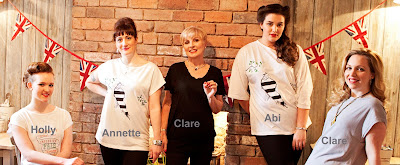I love wearing and designing with cotton, particularly knitted cotton in the form of cotton jersey. I cannot imagine life without t-shirts and the soft drape of good quality cotton jersey for styled tops and dresses. Cotton takes on many forms, from my own favourite knitted jersey to woven cotton turned into clothing and a vast array of cottons used for interior textiles.
Picture of International Cotton Production (Figures from Index Mundi)
I have trawled through plenty of information about cotton production and it would be easy to summarise other organisations'/organic manufacturers' thoughts as their arguments are quite compelling but I wanted to start this with a clear picture of where cotton is grown and the quantities which are produced.
Total World Production estimated for 2012 -
7,619,500 tonnes
1.China
29.2%
2.India
21.27%
3.USA
14.19%
4.Pakistan
7.76%
5.Brazil
5.25%
6.Uzbekistan
3.75%
7.Australia
3.5%
8.Turkey
2.17%
9.Turkmenistan
1.33%
10.Greece
0.96%
The remainder of world cotton production is divided between 67 different countries and totals
10.62%
You may be interested to note that Egypt, which I believed to be one of the top ten major cotton producers accounts for less than 0.5% of world cotton production but when you consider the weight of cotton they produce, 112,115.5 tonnes per year, it's not an insignificant amount. It seems that I am not in the minority with my love of cotton.
Agricultural land used for cotton crops account for 2.5% of total global agricultural land yet 10% of all pesticides and 22% of all insecticides are used in the cotton growing process. Many of these are extremely toxic with 3 being in the dirty dozen banned (but still in use) by 120 countries at a UNEP conference in 2001. Five are thought to be probable carcinogens. Aerial spraying is frequently used which means potential drift onto farm workers, neighbouring wildlife and communities
Human Cost
The World Trade Organisation estimates that 20,000 deaths and 3 million chronic health problems are caused by using agricultural pesticides. This does not take into account the illnesses which are not classified as chronic. The Soil Association state that 77 million cotton workers are poisoned from pesticides each year.
Cost to the Environment
Conventional cotton production uses more water than organic methods and relies on mono-crop culture. Toxicity travels right through the cycle of conventional cotton production from the seeds being treated with fungicide to pesticide/insecticide use during growing time through to the defoliating of the cotton crop with toxic chemicals. Whilst the developing world is blamed for the use of these chemicals, the USA uses approximately 70% GMO cotton. GM company Monsanto also controls 95% of the cotton seed market in India.
Heavy pesticide use reduces biodiversity, disrupts eco systems and contaminates water supplies. Pests also build up a resistance to the pesticides so each year, the farmers increase pesticide quantities to try and achieve a consistent crop yield.
Debt Spiral - More Human Cost
The additional pesticide increases the farmers' production costs and leads to severe poverty. This is so extreme that in some parts of India, this has meant that thousands of farmers have committed suicide
The Benefits of Organic Cotton
Some of the benefits are pretty obvious. Organic cotton farming doesn't use pesticides or GM seed. This hugely benefits the cotton workers, local communities and the environment.
Benefits for Farmers
Organic farmers clearly enjoy better health than their counterparts who expose themselves to chemical poisoning. As organic farming entails the cultivation of a diverse range of crops to maintain healthy soil, this also means that the farmers are less exposed to price volatility, changes in market demand and climate variation. This leads to a better income and life for the farmers.
Healthy Soil & Water Supply
Organic soil is healthy as crops are rotated. This healthy soil also retains water better than non organic soil which is therefore better during drought and preserves precious water. Water pollution does not occur.
Organic practices turn the soil into a carbon sink which absorbs CO
2
Weed control is done physically by hand instead of with chemicals. There is a balance between pests and their natural predators. Biological and cultural practices are used to control pests. 'Trap Crop' may be used to lure harmful insects away from the cotton crop.
Sustainability & Combating Climate Change
Eliminating the use of manufactured fertilisers and pesticides and reducing nitrogen inputs, organic cotton growing produces up to 94% less greenhouse gas emissions. As mentioned above, CO2 is taken out of the atmosphere by healthy organic soils which absorb carbon.
Organic farming uses less energy.
"Research shows that organic agriculture is a good option for food security...and is more sustainable in the long term" United Nations Conference of Trade & Development.
Growing Demand for Organic Products
When I first started sourcing organic cotton I thought I would find boring ecru fabric which felt a little rough. Happily, I was wrong, the organic clothes and fabric I have discovered in the last couple of years are smooth and soft to wear and show no visible signs of a 'do gooder' badge.
The organic cotton business is small but developing. According to a report by Textile Exchange, 2010 Global Market Report on Sustainable Textiles, global sales of organic cotton apparel and home textile products reached an estimated $5.16 billion in 2010. This reflects a 20 percent increase from the 2009 market. Organic cotton now equals 0.7 percent of global cotton production.
It's not difficult to see why there is a growing demand for organic products. In the clothing sector, good organic clothes can be more difficult to find and a little more expensive but when you look at the whole picture, the benefits far outweigh the disadvantages. With increased consumer awareness and desire, the availability of organic clothes will increase as retailers and e-tailers bend towards their customers' desire for organic cottons.




a.jpg)








